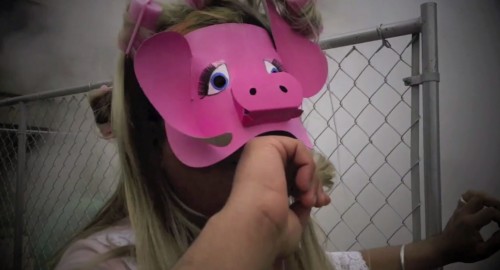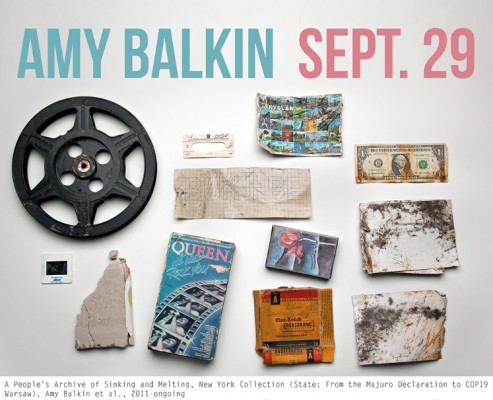
Still from Anuj Vaidya’s short film Miss Piggy, Live with Diane Sawyer (2013)
A visiting artist and exhibition series sponsored by the undergraduate Fine Art department, open to the campus community and to the public, is bringing diverse voices and points of view to Art Center. (See full schedule of upcoming programs below.)
“Art students need to see a mix of people and perspectives, otherwise their assumptions about life, society and art are not questioned,” says Fine Art Chair Vanalyne Green. “And what is an art education for, if not to pose questions?”
The programming includes lectures, screenings, performances and exhibitions designed to expose students to artists whose work is thought-provoking and, in many cases, boundary-defying.
Last month, artist, educator and film curator Anuj Vaidya presented “Colour Me Queer: LGBTQ Voices From India,” an array of queer experimental shorts created by himself and others over the past decade.
Vaidya’s own work straddles film and live performance, and his tour de force presentation at South Campus on August 4 included his Aur Pachhim: Transvestites in Space (11 mins, 2010). In this high-camp science fiction fantasy, a pod of sterilized male transvestites is sent off to the moon to shop and smoke, in order save Earth’s ailing economy. It’s a neo-benshi reworking of the 1970 Indian film Purab aur Pachhim, to often comic effect, as Vaidya performs an entirely new script, unrelated to the film’s original narrative, voicing all the actors himself.
Parodying American culture, in Miss Piggy, Live with Diane Sawyer (11 mins, 2013) Vaidya plays Miss Piggy as Diane Sawyer interviews her about her new celebrity cause, ecology, and her chance encounters with Earth goddesses from different mythological traditions, who give Miss Piggy the gift of a human-powered energy solution for the production her upcoming directorial debut.
There’s a deliberately unfinished, technically imperfect quality to both the film and the performance work. All its seams are showing: Vaidya’s live reading does not sync up with the characters in the film; “Diane Sawyer” looks nothing like TV’s actual Diane Sawyer; and the flimsy pink Miss Piggy mask constantly falls off Vaidya’s face.
In spite of all this, sincere and even poignant moments abound. The viewer, witnessing the sheer amount of physical and imaginative exertion involved, experiences empathy — as much for the artist as for his characters. Notably, the Miss Piggy film was produced with zero carbon footprint: Vaidya used stationary bicycles and hand cranks to power the energy used for the shoots.
“I invited Anuj Vaidya to present at Art Center because his work represents a voice that needs to be heard,” says Green, his former teacher, “one that argues for levity, humor, irony and the fabulous in the sense of ‘fable.’ Vaidya’s work advocates for a redefinition of queer — unsanctified by Hollywoodian linear narratives and yet completely happy to camp on to such plots. Film scholar and critic B. Ruby Rich has put forward works such as Vaidya’s as a repositioning of both the center and the margins, in which a queer aesthetic refuses to live at the edges but simultaneously subverts the putative purity of the center.”

Schedule of upcoming programs in the Fine Art series:
Amy Balkin – Mon., Sept. 29, 7:30 p.m. in the Wind Tunnel Gallery at 950 S. Raymond Ave. (lecture and discussion, co-sponsored by Media Design Practices)
San Francisco-based artist Amy Balkin, who has been working on climate change-related projects since 2004, will speak about her ongoing project, “A People’s Archive of Sinking and Melting.” It’s a collection of publicly submitted items — ordinary objects from everyday life charged with new meanings — from places that could be on the brink of disappearance due to climate change.
“A century from now, if the world has been ravaged by sea level rise, glacial melt, flooding, drought and other forms of extreme weather driven by climate change, this collection will give our descendants tangible evidence of the beginning of the end,” The Smithsonian magazine writes of the project.
Art21 situates “A People’s Archive” in an art historical context, noting, “The speculative aspects of Balkin’s work are redolent both with science fiction narratives and historical utopias from a variety of different periods and cultural locations. The Paris Commune comes to mind, but so does Afro-Futurism, or the work of Samuel Delaney.”
Althea Thauberger – Mon., Oct. 27, 7 p.m. (screening and discussion)
Canadian artist Althea Thauberger presents “Marat Sade Bohnice,” a project she created for The Power Plant Contemporary Art Gallery in Toronto. An experimental documentary/video installation about the staging of Peter Weiss’s 1963 play Marat/Sade at the Bohnice Psychiatric Hospital in Prague, the work approaches issues of institutionalization and shifting political terrain.
Per The Power Plant: “While Althea Thauberger’s practice defies strict definition by medium, she has produced remarkable films, videos, photographs, and performances over the course of her decade-long career. Driven by her interest in, and unique facility for, collaboration, the thread that connects her projects is her thoughtful engagement with groups of people — most often well-defined social enclaves — as her subjects. She works with these communities to develop performances that offer the participants opportunities for self-exploration and self-definition. The final works — whether videos or photographs, produced by Thauberger to record the collaborations — are always striking documents that entice, engage and surprise her viewers.”
Juli Carson — Mon., Nov. 17, 7 p.m. (lecture and discussion)
Juli Carson — art historian, critic and curator — will discuss “The Politics of Failing.” She is professor of critical and curatorial studies at UCIrvine, and director of three of the university’s art galleries. Her academic research focuses on the effect that legacies of 1960s Minimalism and 1970s Conceptualism has had on a branch of contemporary art informed by psychoanalysis, and her art criticism is widely published. Her most recent book is The Limits of Representation: Psychoanalysis and Critical Aesthetics (Letra Viva Press, 2011).
“U.S. Presidents and the Mona Lisa” – on view through Dec. 5 (exhibition co-sponsored by the Illustration department, with support from the Council on Diversity and Inclusion)
The presentations by Thauberger and Carson are being held in conjunction with “U.S. Presidents and the Mona Lisa,” an exhibition of paintings by self-taught African-American artist Ike Morgan in Art Center’s Hutto-Patterson Exhibition Space, 870 S. Raymond Ave.
Hospitalized on a long-term basis for treatment of schizophrenia in Austin, Texas, “Morgan coped with mental illness by turning to art making,” writes April Bey, Fine Art Department coordinator, in her essay for a catalog for the Morgan exhibition, underwritten by both departments and with additional texts by professional arts journalist Dana Boutin and Fine Art student Brian Tarpey. “Using cheap poster board saturated with greasy oil sticks and water-based inks Morgan creates childlike portraits inspired by photographs from literature and magazines.”
Bey, an artist herself, grew up in the Caribbean, and her current work critiques American popular culture and explores themes of racial ambiguity and nontraditional racism. She invites us to “step inside of the outsider by seeing [Morgan’s] work.”









There is perceptibly a bunch to identify about this. I consider you made some good points in features also.
I have realized that over the course of making a relationship with real estate entrepreneurs, you’ll be able to get them to understand that, in most real estate transaction, a percentage is paid. In the end, FSBO sellers never “save” the fee. Rather, they struggle to win the commission by means of doing a agent’s work. In doing so, they commit their money along with time to conduct, as best they will, the duties of an adviser. Those jobs include displaying the home by marketing, representing the home to willing buyers, creating a sense of buyer urgency in order to prompt an offer, arranging home inspections, managing qualification assessments with the bank, supervising repairs, and facilitating the closing.